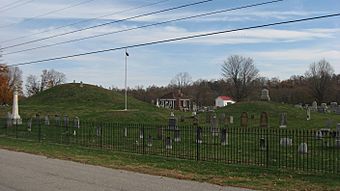Piketon Mounds facts for kids
Quick facts for kids |
|
|
Piketon Mounds
|
|

Overview from southwest
|
|
| Location | Mound Cemetery, south of Piketon |
|---|---|
| Nearest city | Piketon, Ohio |
| Area | 3 acres (1.2 ha) |
| NRHP reference No. | 74001599 |
| Added to NRHP | May 2, 1974 |
The Piketon Mounds (also known as the Graded Way) are a fascinating group of ancient earthworks found in Piketon, Ohio in the United States. These amazing structures are listed on the National Register of Historic Places, which means they are important historical sites.
Scientists aren't exactly sure when these earthworks were built. Some parts were made by the Adena culture, an ancient group of people. Other parts were built by the Hopewell culture, another early civilization. This mix of cultures makes it tricky to figure out a single date for the entire site.
Contents
Where are the Piketon Mounds?
The Piketon Mounds are located right in Piketon, Ohio. A long time ago, around 1848, a road called the Chillicothe Turnpike went through the site. Also, a cemetery was built on top of some of the mounds. This cemetery, called Mound Cemetery, is still there today.
Exploring the Ancient Earthworks
People have been studying the Piketon Mounds for a long time. Early explorers helped us understand what these ancient structures looked like.
What Squier and Davis Found (1840s)
Two important explorers, Ephraim George Squier and Edwin Hamilton Davis, visited the Piketon Mounds in the 1840s. They wrote about the site in their famous book, Ancient Monuments of the Mississippi Valley, published in 1848. They called the site the "Graded Way."
They described the Graded Way as a special type of earthwork. It was like a ramp or pathway that went up from one level of land to another. They noted that it was 1,080 feet long. At different points, it was about 203 to 215 feet wide.
The Graded Way's Design
Squier and Davis saw that the Graded Way went up from a second terrace (a flat, raised area of land) to a third terrace. The third terrace was 17 feet higher than the second. Along the sides of this graded path, there were embankments, which are like raised walls of earth. These walls were between 5 and 11 feet tall. In one section, the walls were even taller, reaching 22 feet high!
When Squier and Davis visited, many trees and bushes covered the earthworks. They thought that people passing by might just see them as natural hills, not something built by humans.
Other Structures Nearby
They also found a smaller embankment that stretched for 2,580 feet from the right side of the Graded Way. Much of this smaller wall was later destroyed by the Chillicothe Turnpike road.
Further away, about 1,500 feet from the main graded path, there was another wall. This wall turned at a right angle and went for 212 feet. Then it ran parallel to the main graded path for 420 feet. Finally, it curved back towards the Graded Way and ended near four mounds. Three of these mounds were small, and one was very large, standing 30 feet high. Squier and Davis noted that the small mounds were being used as a cemetery at the time, which is still true today.
On the left side of the Graded Way, the path led down to a lower area that often filled with water. Squier and Davis believed that the Scioto River might have flowed through this area in the past.
Squier and Davis wondered what the Graded Way was used for. They thought it might have been a way to get from one terrace to another. However, the tall embankments made them question this idea. In their report, they didn't give a definite answer about its purpose.
What the Piketon Mounds Look Like Today
Today, the Piketon Mounds site still features four mounds within the cemetery. Three of these mounds are smaller, ranging from two to five feet high. The largest mound is quite impressive, measuring 75 feet across and 25 feet high.
Past excavations have revealed interesting things. For example, one of the mounds was reported to contain a human skeleton of a girl. She was found wrapped in bark.
The Graded Way is also still visible. The Ohio History Connection describes it as a "natural drainage channel" now. The mounds themselves are typical of the Adena culture. However, the Graded Way is more commonly linked to the Hopewell culture. Because both cultures contributed to the site, it's difficult to pinpoint an exact date for when all the works were created.



